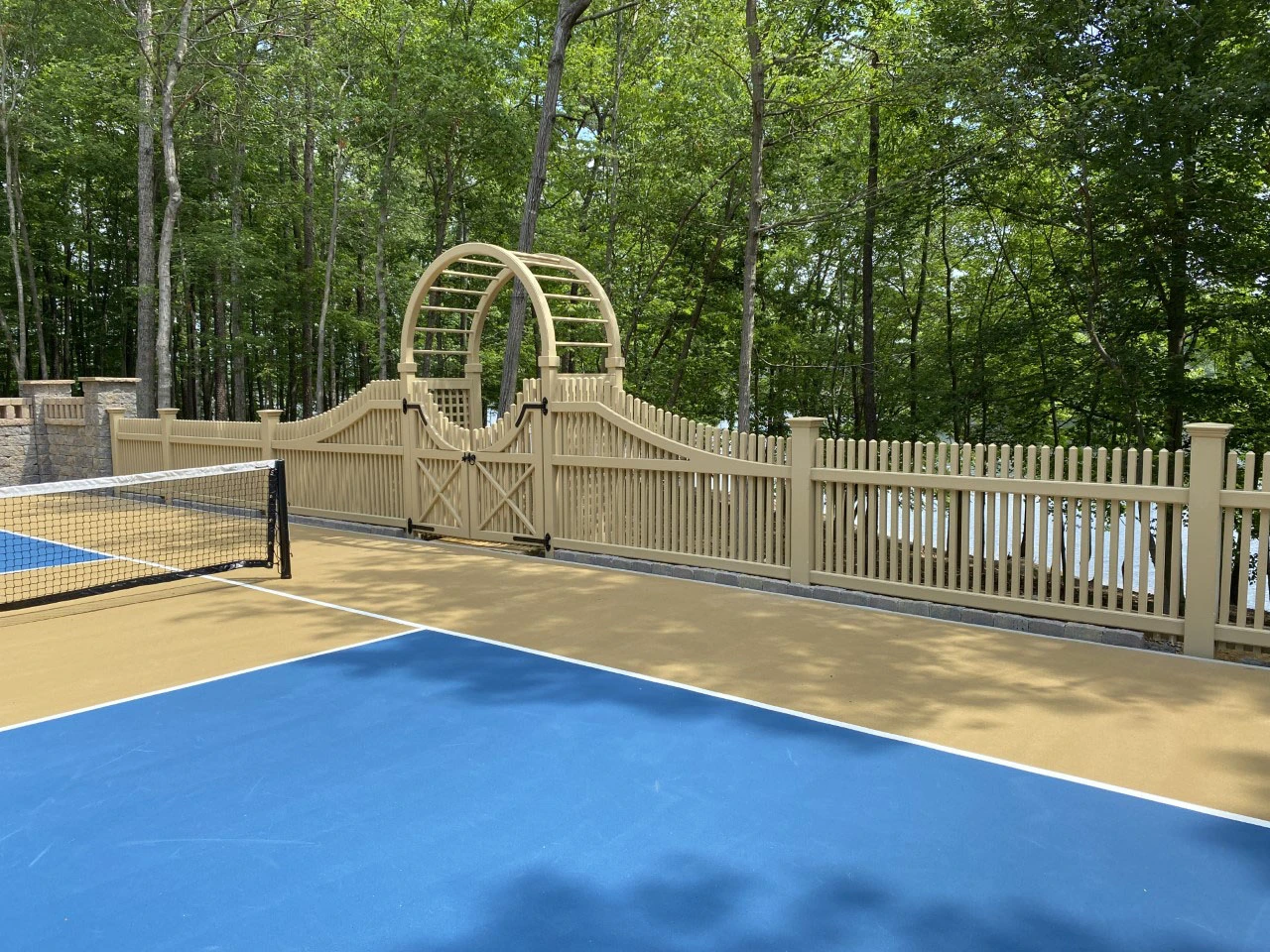Pickleball has evolved from a backyard invention in the 1960s into America's fastest-growing sport, with millions of players enjoying its unique combination of tennis, badminton, and table tennis elements. Strong demand for new courts and facilities has created unprecedented interest in pickleball court construction among communities, clubs, and private homeowners. As court construction increases, fencing has become an essential design element that provides safety, durability, and aesthetic appeal while enhancing the overall playing experience.
The Role of Fencing in a Pickleball Court Design
Fencing defines pickleball court boundaries while ensuring balls remain contained and spectators stay protected from errant shots. Court enclosures protect nearby landscaping, buildings, and pathways from ball impact while creating consistent playing environments that reduce distractions and provide clear game visibility for players and observers.
Pickleball courts require different dimensional considerations than tennis courts, making proper fence scaling essential for functionality and visual proportion. Effective fencing design balances practical containment needs with aesthetic integration that complements surrounding architecture. Thoughtful planning transforms necessary safety barriers into attractive design elements that enhance playing conditions and property appeal.
What to Consider Before Installing Pickleball Fencing
Court Dimensions and Layout
Pickleball courts measure 20 by 44 feet for both singles and doubles play, significantly smaller than tennis court dimensions. Fencing systems should accommodate these proportions without overwhelming the court visually or creating claustrophobic playing conditions. Entry gate placement requires careful consideration to allow smooth player access while accommodating maintenance equipment and spectator flow patterns.
Proper clearance areas beyond court boundaries affect fencing placement and height requirements. Understanding these spatial relationships ensures optimal playing conditions while maximizing efficient use of available property area.
Height Requirements
Standard pickleball fencing ranges from 8 to 10 feet in height, with specific requirements varying based on court location and intended use patterns. Multi-court facilities or courts near property boundaries may benefit from taller enclosures for enhanced containment and privacy. Private residential courts might utilize lower heights where visual openness takes priority over maximum ball retention.
Height selection should balance effective ball containment with appropriate visual scale that maintains pleasing proportions relative to court size and surrounding landscape elements.
Material Durability and Performance
Fencing materials must withstand frequent ball impact while maintaining structural integrity through changing weather conditions. Quality materials resist warping, fading, and degradation that can compromise both appearance and function over time. The Sag Harbor Court Fence demonstrates how solid cellular vinyl construction provides painted wood aesthetics with superior durability and minimal maintenance requirements.
Secure post installation and robust framing prevent structural movement or fence failure that could affect playing conditions or safety. Quality construction ensures long-term performance that protects both investment value and user safety.
Aesthetic Integration with Surrounding Architecture
Pickleball courts often occupy prominent positions within residential backyards, country club facilities, or community recreation areas. Fence design should complement existing architectural elements while enhancing overall property aesthetics rather than creating visual conflicts. Color coordination, post styling, and gate detailing can be customized to match other outdoor structures and landscape features.
Well-integrated court fencing becomes a positive architectural element that adds value and visual appeal rather than appearing as purely utilitarian infrastructure.
Safety and Visibility Considerations
Clear sightlines benefit both active players and spectators while maintaining necessary safety barriers. Fence designs must provide reliable ball containment without creating visual obstructions that interfere with gameplay or spectator enjoyment. Mesh spacing, framing profiles, and material selections can be optimized to achieve safety and visibility objectives.
Smooth edge finishing, reliable hardware specifications, and properly functioning gates contribute to overall safety while ensuring convenient access for players, maintenance staff, and emergency personnel when needed.
Pickleball Court Fencing Options
Contemporary Post and Wire Systems
Post and wire fencing provides maximum visibility with minimal visual interference, making it popular for multi-court facilities where clear sightlines between adjacent games are essential. The Sag Harbor design offers contemporary framing with sleek lines and maximum transparency while maintaining necessary structural strength. This approach combines practical functionality with modern aesthetic appeal.
Solid Cellular Vinyl Construction
Premium solid cellular vinyl fencing delivers refined aesthetics suitable for discerning homeowners while providing exceptional durability. The material replicates the appearance of painted wood while eliminating maintenance requirements associated with natural materials. The Aquidneck Court Fence demonstrates how solid construction maintains an elegant appearance through demanding outdoor conditions without fading, warping, or structural degradation.
Lattice and Hybrid Design Options
Some installations benefit from combination approaches that blend different fencing elements for optimized performance. The 2-inch HV Lattice Court Fence provides structured containment with classic lattice aesthetics. Hybrid designs might incorporate solid sections at lower levels with open wire sections above, creating privacy near ground level while maintaining elevated visibility.
Custom Gate Integration
Access gates serve functional requirements while creating architectural focal points that enhance overall court presentation. Custom gate designs range from traditional styles to contemporary horizontal applications, each contributing personality and convenience to court enclosures. Reliable latching mechanisms and smooth operation ensure both safety and user convenience for years of dependable service.
Upgrade Your Outdoor Space with Customizable Pickleball Court Fencing
Our Walpole Outdoors team specializes in crafting pickleball court enclosures that balance safety requirements, structural durability, and architectural refinement. Each installation utilizes premium solid cellular vinyl or other high-performance materials that ensure decades of reliable service with minimal maintenance obligations. Customizable styling options and finish selections allow seamless integration with existing architectural elements, whether your preferences lean toward clean contemporary aesthetics or traditional design approaches.
Professional design consultation ensures your court fencing meets both functional requirements and aesthetic objectives while providing lasting value for your property investment. Quality materials and expert craftsmanship create enclosures that enhance both playing experience and property presentation.
Explore the Walpole Outdoors Racquet Court Enclosures Product Guide to discover how professional fencing solutions enhance both court functionality and visual appeal. Ready to begin planning your custom pickleball court enclosure? Schedule a complimentary consultation with our design experts to create an installation that reflects your property's character while providing lasting performance and value.
Resources
https://www.playpickleball.com/pickleball-history-timeline/
https://picklego.co/blog/history-of-pickleball/
https://www.onixpickleball.com/blogs/learn-pickleball/pickleball-court-dimensions
